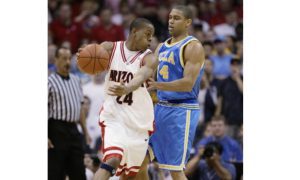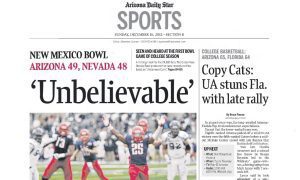Imagine being rescued from a deserted island after getting lost following the Arizona Wildcats’ last trip to the Final Four in 2001, a long 16 seasons ago.
After being dumbfounded with newspapers becoming practically extinct, you discover on that wild thing called the Internet that Arizona is 16-2 overall.
With that kind of record, the Wildcats must be another top 10 team in the AP Top 25, you think. Maybe even top 5.
Try No. 14.
Man, this world has really changed, you wonder.
A 16-2 Arizona team in mid-January not in the top 10? Seven teams with two or three losses are ranked higher? Both teams Arizona lost to by a combined 11 points — No. 4 Gonzaga and No. 13 Butler — are ranked higher yet 16 wins and not in the top 10?
In researching past AP Top 25 rankings to Jan. 15, eight times including this season has Arizona had two losses to this point. The No. 14 ranking is the lowest of them all.
The list:
1988-89: 9-2 (No. 12)
1990-91: 13-2 (No. 6)
1991-92: 10-2 (No. 7)
1992-93: 7-2 (No. 12)
1993-94: 13-2 (No. 9)
1999-00: 15-2 (No. 2)
2014-15: 14-2 (No. 10)
2016-17: 16-2 (No. 14)
The 1988-89 and 1992-93 teams were not in the top 10 with only two losses at this point of the season but those teams played far less games because of fewer non-conference games. And they were ranked two spots higher than what Sean Miller’s team is ranked now.
The reason back then for the fewer games through this time of the season: The Wildcats played non-conference opponents in the middle of the Pac-10 season the same week they played Arizona State.
Another stat: Seventeen times since the Lute Olson era started has Arizona not been in the top 10 when the calendar hit Jan. 15. Arizona’s 16-2 record is the highest winning percentage (.889) of those excluded from the top 10.
The list:
[table “” not found /]Miller’s 2010-11 team proved to be the most slighted not ranked until Jan. 31 that season. You would think an Arizona team that is 14-3 would at least be ranked but the Wildcats’ best win at that point was on the road against a North Carolina State team that finished 15-16 that season.
The Wildcats won 30 games that season, captured the regular-season Pac-10 championship and came a couple of missed 3-pointers against UConn from making the Final Four.
Will the same slight (in the long run) hold true this season? Check back in March after Arizona has a chance to completely prove itself like Derrick Williams and Co. did six seasons ago.
The lower-than-expected ranking presently has all to do with Arizona’s quality victories or lack thereof.
Arizona is 0-2 against the RPI Top 25 — Butler is No. 4 and Gonzaga No. 9.
The Wildcats’ best wins are against Michigan State (No. 41 RPI) and California (No. 49).
At least the Wildcats are 7-2 against their top 100 RPI opponents and they have no poor losses.
But this is where Miller’s team is affected the most and why AP voters can argue that Arizona is not a top 10 team: The Wildcats have six wins against teams ranked No. 152 or lower in the RPI.
The Wildcats’ overall strength-of-schedule rating is No. 31. Not bad. The problem is their conference strength-of-schedule rating, which is No. 85. Arizona’s wins over ASU, Colorado, Utah, Stanford and Cal do not help their RPI or make AP voters believe Miller’s group is a typical dominant Arizona team yet.
Arizona can make a statement this week playing formerly-ranked USC and No. 3-rated UCLA on the road.
A sweep and Arizona’s perception among voters changes to a top 5 team at 18-2 with a win over the mighty Bruins with wunderkind Lonzo Ball. A split probably keeps its ranking about the same especially if it’s a win over USC and loss to UCLA. The opposite with a win over UCLA might boost Arizona closer to No. 10.
Getting swept should not be a surprise because of the level of difficulty, yet the Wildcats will probably drop out of the top 20 and be ranked No. 21 or so.
Regardless of what takes place in Los Angeles, keep this mind: What matters most is what happens at the end. The 2010-11 team is a prime example of that.
FOLLOW @JAVIERJMORALES ON TWITTER!
ALLSPORTSTUCSON.com publisher, writer and editor Javier Morales is a former Arizona Press Club award winner. He is a former Arizona Daily Star beat reporter for the Arizona basketball team, including when the Wildcats won the 1996-97 NCAA title. He has also written articles for CollegeAD.com, Bleacher Report, Lindy’s Sports, TucsonCitizen.com, The Arizona Republic, Sporting News and Baseball America, among many other publications. He has also authored the book “The Highest Form of Living”, which is available at Amazon.


















